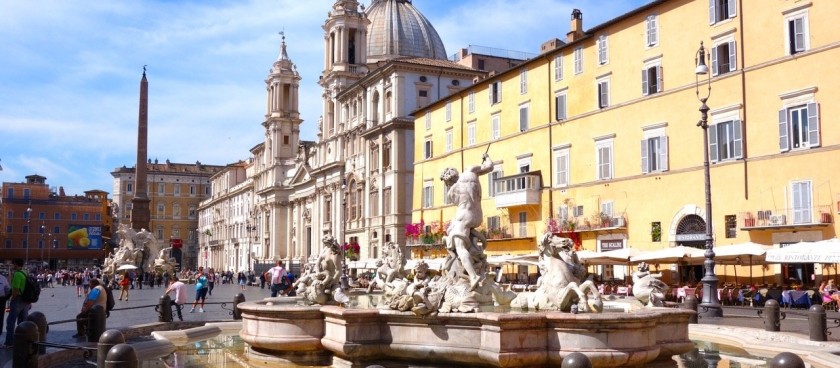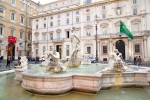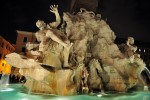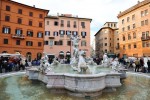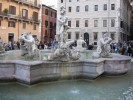- #IT07
- Piazza Navona, 00186 Roma, Italy
- 41.8991700, 12.4730770 Copy to clipboard Copy
-
#Towns
History
Defined as a public space in the last years of 15th century, when the city market was transferred there from the Campidoglio, Piazza Navona was transformed into a highly significant example of Baroque Roman architecture and art during the pontificate of Innocent X, who reigned from 1644 until 1655, and whose family palace, the Palazzo Pamphili, faced the piazza. It features important sculptural and creations: in the center stands the famous Fontana dei Quattro Fiumi or Fountain of the Four Rivers (1651) by Gian Lorenzo Bernini, topped by the Obelisk of Domitian, brought in pieces from the Circus of Maxentius; the church of Sant'Agnese in Agone by Francesco Borromini, Girolamo Rainaldi, Carlo Rainaldi and others; and the aforementioned Pamphili palace, also by Girolamo Rainaldi, that accommodates the long gallery designed by Borromini and frescoed by Pietro da Cortona.
Piazza Navona has two other fountains. At the southern end is the Fontana del Moro with a basin and four Tritons sculpted by Giacomo della Porta (1575) to which, in 1673, Bernini added a statue of a Moor, wrestling with a dolphin. At the northern end is the Fountain of Neptune (1574) also created by Giacomo della Porta; the statue of Neptune, by Antonio Della Bitta, was added in 1878 to create a balance with La Fontana del Moro.
During its history, the piazza has hosted theatrical events and other ephemeral activities. From 1652 until 1866, when the festival was suppressed, it was flooded on every Saturday and Sunday in August in elaborate celebrations of the Pamphilj family. The pavement level was raised in the 19th century, and in 1869 the market was moved to the nearby Campo de' Fiori. A Christmas market is held in the piazza square.
Fountains of Piazza Navona
The most beautiful parts of Piazza Navona are its three fountains, designed during the papacy of Gregory XIII:
Fontana dei Quattro Fiumi
Erected in the centre of Piazza Navona, the Fontana dei Quattro Fiumi (Fountain of the Four Rivers) was designed by Bernini in 1651. The four statues represent the most important rivers of the continents where Christianity had spread; the Nile, Danube, the Ganges and Rio de la Plata. In the middle there is an obelisk measuring 52 ft (16 m), which had originally been part of the Circus of Maxentius, found in the Appian Way Regional Park.
Fontana del Moro
Sculpted by Giacomo della Porta and later perfected by Bernini, who added the figure of the Moor, the fountain was initially called the “Seashell Fountain.” This fountain is located on the southern side of the square.
Fontana del Nettuno
The Fontana del Nettuno (Fountain of Neptune) was also created by Giacomo della Porta in 1574, but remained unfinished for approximately three-hundred years, until 1878, when it was decorated by Antonio Della Bitta and Gregorio Zappalà.
Interesting facts
Until mid-nineteenth century, every summer the drains of the three fountains were blocked and the centre of the square was flooded to make the “Lake of Piazza Navona”. It was greatly enjoyed by the locals.
A charming area
The square is surrounded by restaurants and terraces giving Piazza Navona a lively and delightful atmosphere during the day. Here, visitors can enjoy performances by street artists like magicians and dancers.
The most imposing buildings which look onto the square are the Church of Sant'Agnese in Agone and the Palazzo Pamphilj.
